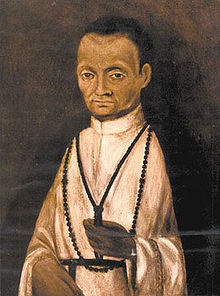St. Martin de Porres is the patron saint of mixed-race people, barbers, innkeepers, public health workers, and all those seeking racial harmony.
Born on December 9, 1579, St. Martin de Porres of the Dominican Order was beatified in 1837 by Pope Gregory XVI and canonized in 1962 by Pope John XXIII becoming the first Black saint in the Americas.
He was born to a Spanish nobleman, Don Juan de Porres, and a young freed Black slave, Ana Velázquez from Panama. He had a sister named Juana, but together with their mother, got abandoned by their father.
Although their mother Ana Velázquez supported her children by taking in laundry, they grew up in poverty. De Porres was sent to a primary school for two years, and then placed with a barber/surgeon to learn the medical arts. He spent hours of the night in prayer, a lifelong practice he undertook till his death. Martin de Porres also lived in self-imposed austerity, never ate meat and fasted continuously.

His great distinction was that “he was noted for his work on behalf of the poor, establishing an orphanage and a children’s hospital. He maintained an austere lifestyle, which included fasting and abstaining from meat. Among the many miracles attributed to him were those of levitation, bilocation, miraculous knowledge, instantaneous cures, and an ability to communicate with animals,” reports the aaregistry.org.
The Black patron saint who hailed from Lima, Peru was often called Saint Martin of Charity; and the Saint of the Broom (for his devotion to his work, no matter how menial). De Porres spent part of his youth with a surgeon-barber where he learned some medicine and how to care for the sick, skills which came in handy later on in his care of the marginalized.
Since racism against Blacks permeated even the church, Peruvian law barred descendants of Africans and Native Americans from becoming full members of religious orders leaving Martin to ask the Dominicans of Holy Rosary Priory in Lima to accept him as a ‘donado’, a volunteer who performed menial tasks in the monastery in return for the privilege of wearing the habit and living with the religious community.
At age 11 he became a servant in the Dominican priory. At the age of 15 he asked for admission to the Dominican Convent of the Rosary in Lima and was received first as a servant boy, and as his duties grew he was promoted to almoner.
Aaregistry.org further notes: “Martin continued to practice his old trades of barbering and healing and was said to have performed many miraculous cures. He also took on kitchen work, laundry, and cleaning. After eight years at Holy Rosary, the prior Juan de Lorenzana, decided to turn a blind eye to the law and permit Martin to take his vows as a member of the Third Order of Saint Dominic. Holy Rosary was home to 300 men, not all of whom accepted the decision of De Lorenzana: one of the novices called Martin a “mulatto dog”, while one of the priests mocked him for being illegitimate and descended from slaves.”

The taunts and name calling, however, did not deter Martin as he got promoted to almoner begging for more than $2,000 a week from the rich to feed 160 poor persons every day as well as care for the sick of Lima. He was put in charge of the Dominican’s infirmary; and was known for his care of the sick and for his spectacular cures. His superiors dropped the stipulation that “no black person may be received to the holy habit or profession of our order.”
De Porres so moved by the have-not established an orphanage and children’s hospital for the poor children of the slums not sparing even the cats and dogs as he built a shelter for the stray ones nursing them back to health.
De Porres is recognised as Papa Candelo in the Afro-Caribbean-Catholic syncretist religion, which is practised in places where African diaspora culture thrives such as Puerto Rico, the Dominican Republic, Cuba, the United States, and his native Peru. Martin de Porres died of fever on November 3, 1639.











